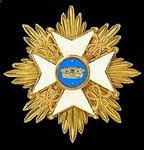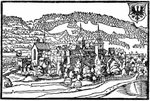
I've been looking into 18th century-style map markers and symbols that are not pictorial (but I'll go back to those shortly). Varied inspiration has been had from the Marburg Archive maps at: http://www.digam.net/?str=177 and maps in the Swedish Archives at: http://www.statensarkiv.se/default.aspx?id=7769#Bochum Some of these vector symbols will work best on small-scale maps, some on large, but I must stress that vector images are very scaleable, unlike raster or bitmap images, which become very pixelly and ugly if enlarged or lose detail if reduced in size. So an apparently too large and detailed vector image can successfully be reduced in size for use on a much smaller-scale map.
On this rough example sheet we have (clockwise from bottom left) the outline of the defences of Mannheim with hornwork to the south over the river, Dresden (top left), Minden (top right), a pentagonal fort or fortified town marker, 2 versions of the star fort marker (with 4 bastions) and a generic town marker with mediaeval town wall (bottom right) (as in the French Academy maps). Bottom centre is a small square schloss with 4 corner towers (this one was at Mannheim). In the centre are two small markers for a field fortification and siegeworks.
All open to development, revision, change, being scrubbed completely, depending on how I feel at the time... ;-)
Friday, 6 February 2009
More map symbols and markers - some experiments
Posted by
David Morfitt
at
Friday, February 06, 2009
0
comments
![]()
Wednesday, 4 February 2009
Fusilier and Grenadier of the Sardinian Swiss Regiment Meyer 1750-1774


 Unit history: First raised January 1744 by a "capitulation" between King Charles Emmanuel III and the Swiss Cantons of Glaris and Appenzel. 1 battalion of 4 companies. Mostly in garrison during the War of the Austrian Succession but involved in a notable action when its fire stopped a French advance on the Assietta ridge in July 1747. Commander from 1744 Adrian Meyer von Herisau. Regiment partly disbanded/partly absorbed by another Swiss regiment in 1774.
Unit history: First raised January 1744 by a "capitulation" between King Charles Emmanuel III and the Swiss Cantons of Glaris and Appenzel. 1 battalion of 4 companies. Mostly in garrison during the War of the Austrian Succession but involved in a notable action when its fire stopped a French advance on the Assietta ridge in July 1747. Commander from 1744 Adrian Meyer von Herisau. Regiment partly disbanded/partly absorbed by another Swiss regiment in 1774.
Uniform: Fusilier (left) Black tricorne, white laced edge, yellow metal button, white strap, mid-blue cockade, yellow-black-red pompom on right side (out of view). Black stock. Very dark (almost Prussian) blue coat, red collar, lapels, cuffs, turnbacks, red edge to shoulder strap. No lace, yellow metal buttons. Heart patches covering hooks and eyes on turnbacks black or very dark blue. Red waistcoat, yellow metal buttons. Red breeches, yellow metal buttons. White inner stocking. White gaiters, white metal buttons.
Grenadier (top) Black fur cap, red bag edged yellow with yellow and red tassel. Black stock. Very dark (almost Prussian) blue coat, red collar, lapels, cuffs, turnbacks, red edge to shoulder strap. No lace, yellow metal buttons. Heart patches covering hooks and eyes on turnbacks black or very dark blue. Red waistcoat, yellow metal buttons. Red breeches, yellow metal buttons. White inner stocking. Black gaiters, white metal buttons.
Posted by
David Morfitt
at
Wednesday, February 04, 2009
6
comments
![]()
Fusilier and Grenadier of the Sardinian Regiment Savoia 1750-1773


 Unit history: Raised 1624. Renamed Savoia 1640. 2 battalions. Some action in the War of the Polish Succession. Heavily involved in the War of the Austrian Succession. Commanders Charles Lodovic Baron du Chabod 1744-1748 Janus Comte D'Eutremon 1748-175? Alexis De La Saunière 175? Giuseppe Della Chiesa Roddi di Cinzano 1767-1772
Unit history: Raised 1624. Renamed Savoia 1640. 2 battalions. Some action in the War of the Polish Succession. Heavily involved in the War of the Austrian Succession. Commanders Charles Lodovic Baron du Chabod 1744-1748 Janus Comte D'Eutremon 1748-175? Alexis De La Saunière 175? Giuseppe Della Chiesa Roddi di Cinzano 1767-1772
Uniform: Fusilier (left) Black tricorne, white laced edge, white metal button, white strap, mid-blue cockade, very dark blue or black and white pompom on right side (out of view). Black stock. Very dark (almost Prussian) blue coat, white collar, lapels, cuffs, turnbacks, white edge to shoulder strap. No lace, white metal buttons. Heart patches covering hooks and eyes on turnbacks black or very dark blue. Dark blue waistcoat, white metal buttons. Dark blue breeches, white metal buttons. White inner stocking. White gaiters, white metal buttons.
Grenadier (top) Black fur cap, dark blue bag edged white with dark blue and white tassel. Black stock. Very dark (almost Prussian) blue coat, white collar, lapels, cuffs, turnbacks, white edge to shoulder strap. No lace, white metal buttons. Heart patches covering hooks and eyes on turnbacks black or very dark blue. Dark blue waistcoat, white metal buttons. Dark blue breeches, white metal buttons. White inner stocking. Black gaiters, white metal buttons.
Posted by
David Morfitt
at
Wednesday, February 04, 2009
0
comments
![]()
Tuesday, 3 February 2009
Fusilier and Grenadier of the Sardinian Regiment La Marina 1750-1773


 Unit history: First raised as militia 1701. Becomes La Marina 1714. One battalion of 10 companies after 1749. Heavily involved in the War of the Polish Succession and the War of the Austrian Succession. Commanders: 1746-1759 Antonio Faletti Compte du Morra 1759-1762 Ignace Thaon du Revel 1762-1769 Camille Compte du Richelmi
Unit history: First raised as militia 1701. Becomes La Marina 1714. One battalion of 10 companies after 1749. Heavily involved in the War of the Polish Succession and the War of the Austrian Succession. Commanders: 1746-1759 Antonio Faletti Compte du Morra 1759-1762 Ignace Thaon du Revel 1762-1769 Camille Compte du Richelmi
Uniform: Fusilier (left): Black tricorne, white laced edge, yellow metal button, white strap, mid-blue cockade. Blue-yellow-blue pompon on right side (out of view). Black stock. Very dark (almost Prussian) blue coat, orangey-yellow collar, lapels, cuffs, turnbacks, yellow edge to shoulder strap. No lace, yellow metal buttons. Heart patches covering hooks and eyes on turnbacks black or very dark blue. Orangey-yellow waistcoat, yellow metal buttons. Dark blue breeches, yellow metal buttons. White inner stocking. White gaiters, yellow metal buttons.
Grenadier (top): Black fur cap, yellow bag with yellow edge and yellow tassel. Black stock. Very dark (almost Prussian) blue coat, orangey-yellow collar, lapels, cuffs, turnbacks, yellow edge to shoulder strap. No lace, yellow metal buttons. Heart patches covering hooks and eyes on turnbacks black or very dark blue. Orangey-yellow waistcoat, yellow metal buttons. Dark blue breeches, yellow metal buttons. White inner stocking. Black gaiters, yellow metal buttons.
Posted by
David Morfitt
at
Tuesday, February 03, 2009
2
comments
![]()
Fusilier and Grenadier of the Sardinian Guards Regiment 1750-1773


 Unit history: Raised 1636. Organised as 2 battalions after 1704. First saw action in the War of the Polish Succession. Heavily involved in the War of the Austrian Succession. Commander: 1744-1769 Giuseppe Ottavio Cacherano Osasco Compte della Rocca
Unit history: Raised 1636. Organised as 2 battalions after 1704. First saw action in the War of the Polish Succession. Heavily involved in the War of the Austrian Succession. Commander: 1744-1769 Giuseppe Ottavio Cacherano Osasco Compte della Rocca
Uniform: Fusilier (left): Black tricorne, white laced edge, white metal button, white strap, mid-blue cockade. Black stock. Very dark (almost Prussian) blue coat, deep red collar, lapels, cuffs, turnbacks, red edge to shoulder strap. White lace, white metal buttons. Heart patches covering hooks and eyes on turnbacks black or very dark blue. Deep red waistcoat, white lace, white metal buttons. Deep red breeches, white metal buttons. White inner stocking. White gaiters, white metal buttons.
Grenadier (top): Black fur cap, deep red bag edged white with white tassel. (1750-3, bag deep red edged yellow with tassel horizontally divided red-yellow-black.) Black stock. Very dark (almost Prussian) blue coat, deep red collar, lapels, cuffs, turnbacks, red edge to shoulder strap. White lace, white metal buttons. Heart patches covering hooks and eyes on turnbacks black or very dark blue. Deep red waistcoat, white lace, white metal buttons. Deep red breeches, white metal buttons. White inner stocking. Black gaiters, white metal buttons.
Posted by
David Morfitt
at
Tuesday, February 03, 2009
4
comments
![]()
Coming next - Fusilier and Grenadier of the Sardinian Guards Regiment 1753-1773

As I've done some Sardinian flags I couldn't resist the siren lure of some Sardinian uniforms. I should really finish the cavalry on which I've been working for ages (e.g. French Cuirassiers Du Roi) but I find the fiddly bits like the shabraques rather wearing at times; infantry are so much more relaxing to do. :-) So I've now completed a fusilier and grenadier of the Sardinian Guards Regiment. It's 3.45am, though, and I just don't have the energy to do the exporting to .png and other faffing about before posting so I'll leave putting up the real templates until tomorrow - which also means that I can check and recheck them before posting and not have the all too common experience of spotting some glitch when I've posted and frantically having to take the image off, fix the original and re-export etc., etc.. Here's a quick snapshot of the very French-style uniforms (except that the colours are very Prussian - dark blue and red, in this case).
Posted by
David Morfitt
at
Tuesday, February 03, 2009
3
comments
![]()
Sunday, 1 February 2009
Source of very useful fonts for maps
![]()

I just thought I'd mention that here on Tom Mouat's site: http://www.mapsymbs.com/fontstuf.html is a very useful source of mapping fonts, especially the Map Icon font and the Napoleonic font.
At the bottom is what's on the Napoleonic font (very useful for maps/plans of battle reports):
And at the top is what's on the Map Icons font.
They're missing a lot of the specific period Central European/German items on which I'm working but it does mean I don't necessarily have to cover everything (unless the energy and urge strike, of course! :-)).
Posted by
David Morfitt
at
Sunday, February 01, 2009
4
comments
![]()

















